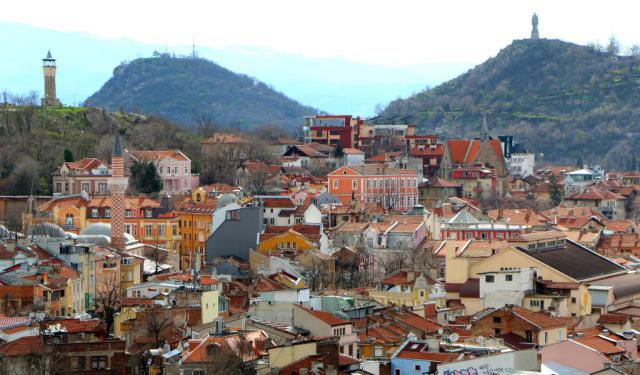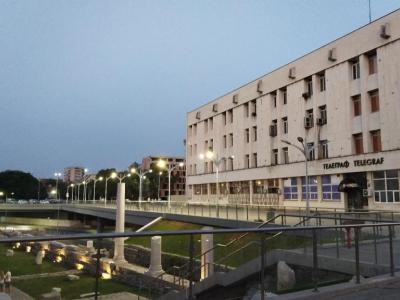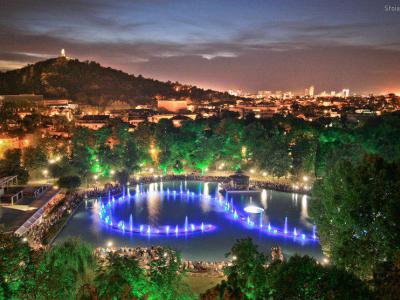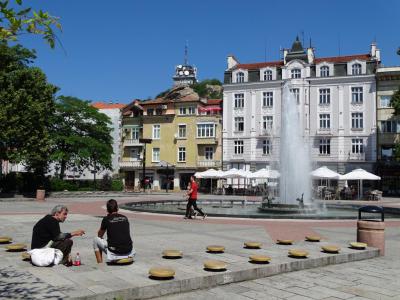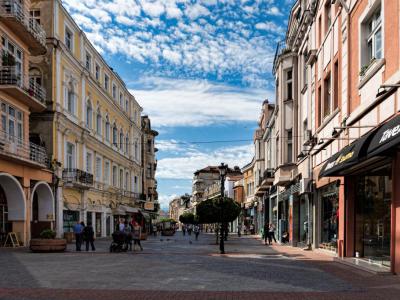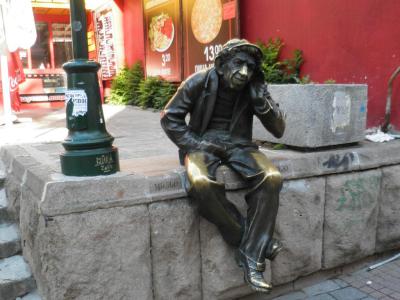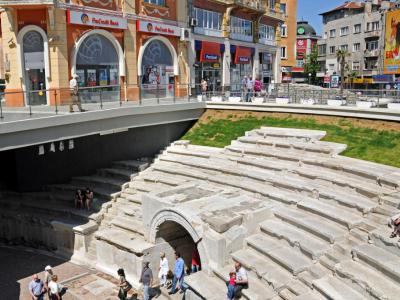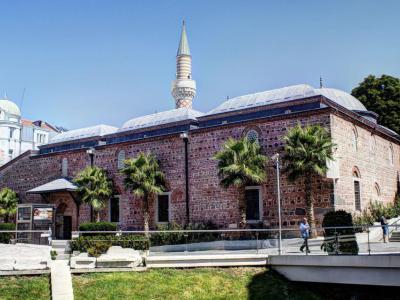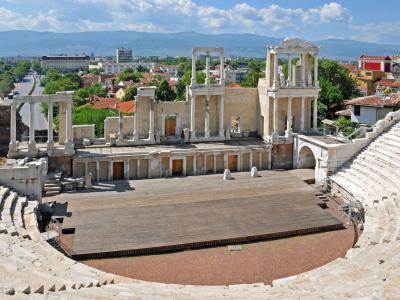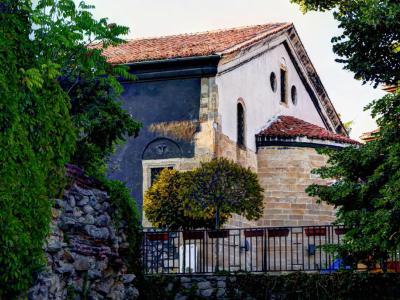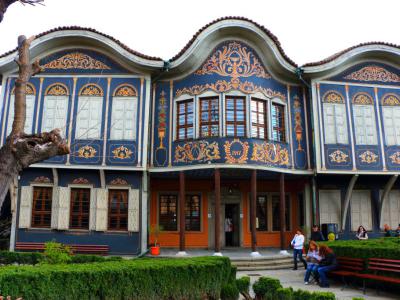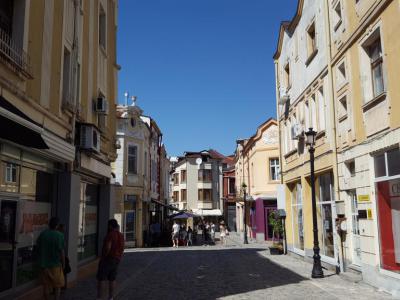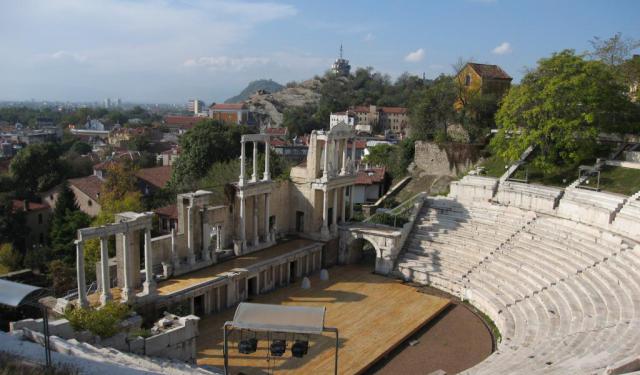Plovdiv Introduction Walking Tour (Self Guided), Plovdiv
Plovdiv is Bulgaria’s second-largest city and one of the oldest continuously inhabited cities in Europe. Nicknamed "The City of the Seven Hills," it boasts over 8,000 years of history, with traces of habitation dating back to the 6th millennium BC. Straddling the Maritsa River in south-central Bulgaria, Plovdiv's thick cultural layers reveal influences from Thracians, Romans, Byzantines, Bulgarians, and Ottoman Turks, shaping it into a vibrant urban center.
The city was founded by Philip II of Macedon in the 4th century BC. It served as a strategic hub in ancient Thrace before enduring conquests by Bulgars and becoming a fortified stronghold. Despite facing sackings and sectarian violence in the Middle Ages, the city persisted, later flourishing as a vital commercial center under Byzantine and Ottoman rule for five centuries.
Throughout its extensive history, Plovdiv has undergone several name changes. Initially known as Philippopolis, in homage to Philip II of Macedon, it had evolved into Pulpudeva by the 6th century CE and later adopted Slavic variants such as Papaldiv and Plovdiv.
Following the Russo-Turkish War in 1878, Plovdiv joined Bulgaria and throughout the 20th century experienced industrial and commercial growth.
Notable local landmarks include the ancient Roman Theatre, Odeon, Aqueduct, and the historic Stadium of Philippopolis which echoes with the cheers of ancient spectators. The Central Square and Roman Agora stand as a testament to the city's ancient heritage, showcasing the remnants of its Roman past amidst the bustle of modern life.
Venturing further, one encounters the tranquil oasis of Tsar Simeon's Garden and the enchanting Singing Fountain, offering respite from the urban hustle. A few blocks ahead, Stefan Stambolov Square bustles with activity, while Knyaz Alexander I Shopping Street beckons with its eclectic mix of stores and boutiques.
Religious sites also abound in the city, from the majestic Djumaya (Friday Mosque) to the Church of Saints Constantine and Helena.
For those eager to delve into Plovdiv's cultural tapestry, the Regional Ethnographic Museum offers a glimpse into the region's rich traditions and customs, while the vibrant Kapana Arts District pulsates with creative energy, showcasing the city's contemporary artistic flair. Today, Plovdiv plays host to various cultural events, including the International Fair, theatrical festivals, and novel events like Night/Plovdiv and Kapana Fest, reflecting its dynamic and evolving character.
If we have piqued your interest, you may wish to embark on this self-guided journey of discovery of Plovdiv wandering through its ancient ruins or exploring its modern venues. Either way, you're bound to get a truly unforgettable experience!
The city was founded by Philip II of Macedon in the 4th century BC. It served as a strategic hub in ancient Thrace before enduring conquests by Bulgars and becoming a fortified stronghold. Despite facing sackings and sectarian violence in the Middle Ages, the city persisted, later flourishing as a vital commercial center under Byzantine and Ottoman rule for five centuries.
Throughout its extensive history, Plovdiv has undergone several name changes. Initially known as Philippopolis, in homage to Philip II of Macedon, it had evolved into Pulpudeva by the 6th century CE and later adopted Slavic variants such as Papaldiv and Plovdiv.
Following the Russo-Turkish War in 1878, Plovdiv joined Bulgaria and throughout the 20th century experienced industrial and commercial growth.
Notable local landmarks include the ancient Roman Theatre, Odeon, Aqueduct, and the historic Stadium of Philippopolis which echoes with the cheers of ancient spectators. The Central Square and Roman Agora stand as a testament to the city's ancient heritage, showcasing the remnants of its Roman past amidst the bustle of modern life.
Venturing further, one encounters the tranquil oasis of Tsar Simeon's Garden and the enchanting Singing Fountain, offering respite from the urban hustle. A few blocks ahead, Stefan Stambolov Square bustles with activity, while Knyaz Alexander I Shopping Street beckons with its eclectic mix of stores and boutiques.
Religious sites also abound in the city, from the majestic Djumaya (Friday Mosque) to the Church of Saints Constantine and Helena.
For those eager to delve into Plovdiv's cultural tapestry, the Regional Ethnographic Museum offers a glimpse into the region's rich traditions and customs, while the vibrant Kapana Arts District pulsates with creative energy, showcasing the city's contemporary artistic flair. Today, Plovdiv plays host to various cultural events, including the International Fair, theatrical festivals, and novel events like Night/Plovdiv and Kapana Fest, reflecting its dynamic and evolving character.
If we have piqued your interest, you may wish to embark on this self-guided journey of discovery of Plovdiv wandering through its ancient ruins or exploring its modern venues. Either way, you're bound to get a truly unforgettable experience!
How it works: Download the app "GPSmyCity: Walks in 1K+ Cities" from Apple App Store or Google Play Store to your mobile phone or tablet. The app turns your mobile device into a personal tour guide and its built-in GPS navigation functions guide you from one tour stop to next. The app works offline, so no data plan is needed when traveling abroad.
Plovdiv Introduction Walking Tour Map
Guide Name: Plovdiv Introduction Walking Tour
Guide Location: Bulgaria » Plovdiv (See other walking tours in Plovdiv)
Guide Type: Self-guided Walking Tour (Sightseeing)
# of Attractions: 11
Tour Duration: 2 Hour(s)
Travel Distance: 2.7 Km or 1.7 Miles
Author: DanaOffice
Sight(s) Featured in This Guide:
Guide Location: Bulgaria » Plovdiv (See other walking tours in Plovdiv)
Guide Type: Self-guided Walking Tour (Sightseeing)
# of Attractions: 11
Tour Duration: 2 Hour(s)
Travel Distance: 2.7 Km or 1.7 Miles
Author: DanaOffice
Sight(s) Featured in This Guide:
- Central Square and Roman Agora
- Tsar Simeon’s Garden and Singing Fountain
- Stefan Stambolov Square
- Knyaz Alexander I Shopping Street
- The Statue of Milyo the Crazy
- Stadium of Philippopolis
- Djumaya (Friday Mosque)
- Roman Theatre of Philippopolis
- Church of St. Constantine and Helena
- Regional Ethnographic Museum
- Kapana Arts District
1) Central Square and Roman Agora
Central Square is a historically significant and culturally rich urban space that has undergone several transformations throughout its existence. The origins of Central Square date back to the late 19th century. At that time, the development of the area around the Central Post Office commenced, leading to the creation of a garden and public space. In recent years, Central Square has transformed into an open-air museum, captivating residents and tourists alike with its historical and cultural treasures.
A major turning point in the square's history occurred in the 1970s and 1980s when the entire area underwent extensive reconstruction. During this process, it became evident that beneath the square lay the remains of the ancient city's central square-the Forum of Philippopolis. As you explore the square, you can witness ongoing excavations of the Roman Forum's ruins, particularly near the overpass steps close to Central Square.
The Forum of Philippopolis, uncovered in 1971 during the construction of the central post office building, comprises the eastern, northern, and part of the southern sections of the ancient central square. The original link between the forum and the Odeon, located on the Northern side, was severed due to the construction of a tunnel beneath Plovdiv's primary pedestrian street. This division effectively bisected the city square, known as the Agora. The open-air large section, known as Area, located in the southern part and accessible from Central Square, is the ancient Agora Commercial section.
Today, visitors can enjoy the lively atmosphere, cafes, and shops while contemplating the rich heritage of Philippopolis, making Central Square an essential destination in Plovdiv.
A major turning point in the square's history occurred in the 1970s and 1980s when the entire area underwent extensive reconstruction. During this process, it became evident that beneath the square lay the remains of the ancient city's central square-the Forum of Philippopolis. As you explore the square, you can witness ongoing excavations of the Roman Forum's ruins, particularly near the overpass steps close to Central Square.
The Forum of Philippopolis, uncovered in 1971 during the construction of the central post office building, comprises the eastern, northern, and part of the southern sections of the ancient central square. The original link between the forum and the Odeon, located on the Northern side, was severed due to the construction of a tunnel beneath Plovdiv's primary pedestrian street. This division effectively bisected the city square, known as the Agora. The open-air large section, known as Area, located in the southern part and accessible from Central Square, is the ancient Agora Commercial section.
Today, visitors can enjoy the lively atmosphere, cafes, and shops while contemplating the rich heritage of Philippopolis, making Central Square an essential destination in Plovdiv.
2) Tsar Simeon’s Garden and Singing Fountain
Tsar Simeon's Garden, often referred to as the 'Lungs of the City' by Plovdiv residents, is a central community hub in the heart of the city. It is a tribute to Bulgaria's most esteemed leader and holds a special place in the city's landscape. Designed and brought to life in 1892 by landscape gardener Lucien Chevalas, the garden occupies the historic site where Plovdiv hosted its renowned Bulgarian Exhibition.
This park beautifully captures the artistic essence of Bulgaria, offering a serene retreat shaded by ancient trees and providing various recreational opportunities. It is also adorned with numerous remarkable sculptures and fountains. Among these, the historic Singing Fountain stands out, having recently undergone an impressive $8 million renovation to delight the public once again.
Stretching over an artificial lake at the very heart of the main garden, the Singing Fountain features an array of customized jets that dance and leap in perfect harmony with a carefully curated selection of compositions, reaching heights of up to 12 meters. As the sun sets, the fountain comes alive with a captivating display of RGB lights, casting a mesmerizing and colorful glow over this beloved community park, enticing visitors to enjoy its beauty late into the evening.
Furthermore, every weekend, spectators are treated to enchanting musical performances by the fountain, and on special occasions, the water jets provide a dazzling backdrop to brilliant fireworks displays.
This park beautifully captures the artistic essence of Bulgaria, offering a serene retreat shaded by ancient trees and providing various recreational opportunities. It is also adorned with numerous remarkable sculptures and fountains. Among these, the historic Singing Fountain stands out, having recently undergone an impressive $8 million renovation to delight the public once again.
Stretching over an artificial lake at the very heart of the main garden, the Singing Fountain features an array of customized jets that dance and leap in perfect harmony with a carefully curated selection of compositions, reaching heights of up to 12 meters. As the sun sets, the fountain comes alive with a captivating display of RGB lights, casting a mesmerizing and colorful glow over this beloved community park, enticing visitors to enjoy its beauty late into the evening.
Furthermore, every weekend, spectators are treated to enchanting musical performances by the fountain, and on special occasions, the water jets provide a dazzling backdrop to brilliant fireworks displays.
3) Stefan Stambolov Square
Situated in the main pedestrian area of the city,Stefan Stambolov Square is a focal point for both locals and visitors. The square is characterized by its picturesque surroundings, with numerous cafes and eateries that provide the perfect setting for enjoying a meal or a cup of coffee while taking in the atmosphere. At the center of the square, there is a central fountain that adds to the charm and ambiance of the area. This fountain is a focal point and a gathering spot for people looking to relax and unwind.
One of the notable landmarks near the square is the historic Plovdiv Municipality building. This quaint old building is a testament to the city's architectural heritage and adds to the square's unique character. The building is often affectionately referred to as "Kopchetata" or "the Buttons" due to the distinct shape of the seats located on its premises.
The historical significance of Stefan Stambolov Square extends back in time. In antiquity, the area housed Roman baths, and remnants of these ancient baths were unearthed during archaeological excavations in the 1930s. Furthermore, during the Ottoman period, the Aladzha Mosque, also known as the Colored Mosque, once graced this site.
In 1997, the square was officially named after Stefan Stambolov, a prominent Bulgarian statesman. To honor his legacy, a monument dedicated to Stefan Stambolov was erected within the square, becoming a notable attraction in its own right.
The square itself offers a range of amenities, including beautiful fountains, a small park adorned with statues, comfortable benches, and a variety of shops and restaurants. During the winter months, the central fountain may be covered, making way for a large Christmas tree, adding a touch of festive charm to the square.
One of the notable landmarks near the square is the historic Plovdiv Municipality building. This quaint old building is a testament to the city's architectural heritage and adds to the square's unique character. The building is often affectionately referred to as "Kopchetata" or "the Buttons" due to the distinct shape of the seats located on its premises.
The historical significance of Stefan Stambolov Square extends back in time. In antiquity, the area housed Roman baths, and remnants of these ancient baths were unearthed during archaeological excavations in the 1930s. Furthermore, during the Ottoman period, the Aladzha Mosque, also known as the Colored Mosque, once graced this site.
In 1997, the square was officially named after Stefan Stambolov, a prominent Bulgarian statesman. To honor his legacy, a monument dedicated to Stefan Stambolov was erected within the square, becoming a notable attraction in its own right.
The square itself offers a range of amenities, including beautiful fountains, a small park adorned with statues, comfortable benches, and a variety of shops and restaurants. During the winter months, the central fountain may be covered, making way for a large Christmas tree, adding a touch of festive charm to the square.
4) Knyaz Alexander I Shopping Street
Knyaz Alexander I Shopping Street, also known simply as the Main Street, is a bustling pedestrian area located in the heart of Plovdiv. This vibrant street serves as a central hub for shopping, dining, and leisure, making it a popular destination for both residents and tourists.
The Main Street commences at Central Square, near the prominent Ramada Plovdiv Trimontium hotel. From there, it extends downwards, offering visitors a delightful stroll through the heart of Plovdiv. Along the way, it passes by several noteworthy landmarks and attractions that add to the street's appeal.
As the Main Street meanders further, it loosely borders the Old Town and The Trap, also known as the Kapana District. These areas are known for their charming and artistic atmosphere, often attracting creative individuals and art enthusiasts. Nearby, the Small Main Street, or Rayko Daskalov Street, offers additional shopping opportunities and cultural experiences.
A prominent shopping destination along the Main Street is the Hali Shopping Center, where visitors can find a diverse range of stores offering fashion, cosmetics, accessories, groceries, pharmacies, bookstores, and much more.
Beyond shopping, the Main Street provides ample opportunities to savor the local cuisine and enjoy a variety of cafeterias and restaurants. It's a place where you can indulge in retail therapy while also relishing the city's culinary delights.
The Main Street commences at Central Square, near the prominent Ramada Plovdiv Trimontium hotel. From there, it extends downwards, offering visitors a delightful stroll through the heart of Plovdiv. Along the way, it passes by several noteworthy landmarks and attractions that add to the street's appeal.
As the Main Street meanders further, it loosely borders the Old Town and The Trap, also known as the Kapana District. These areas are known for their charming and artistic atmosphere, often attracting creative individuals and art enthusiasts. Nearby, the Small Main Street, or Rayko Daskalov Street, offers additional shopping opportunities and cultural experiences.
A prominent shopping destination along the Main Street is the Hali Shopping Center, where visitors can find a diverse range of stores offering fashion, cosmetics, accessories, groceries, pharmacies, bookstores, and much more.
Beyond shopping, the Main Street provides ample opportunities to savor the local cuisine and enjoy a variety of cafeterias and restaurants. It's a place where you can indulge in retail therapy while also relishing the city's culinary delights.
5) The Statue of Milyo the Crazy
The Statue of Milyo the Crazy is one of the city's most iconic and Instagram-worthy landmarks. Visitors and locals alike flock to the cascading water stairs adorned with the word "Together," where they often pause by the bronze statue seated casually to one side. Legend has it that if you whisper your wishes into the monument's ear, they will come true. But who is Milyo, and why is his likeness immortalized in this prominent spot in the City under the Hills?
Milyo Ludia, known as the Plovdiv Bohemian, is one of the most renowned jesters in the city's history. Born as Mihail Dimitrov Todorov, he is now remembered not by his birth name but by his eccentricity and amiable nature. The people of Plovdiv have differing opinions about the cause of his mental instability. Some believe that his intellect, coupled with his ability to speak multiple languages, led to his madness due to excessive reading. Another, more plausible, version suggests that he suffered from meningitis as a child, which hindered his mental development.
Milyo was the subject of various legends, some of which highlighted his perceived virility. He was a familiar face to everyone on Main Street, where he often playfully teased young girls and engaged in light-hearted banter. Unfortunately, not everyone treated him kindly, and he occasionally became the target of cruel jokes. It is said that he passed away in poverty, succumbing to the flu.
The sculpture was crafted by the skilled artist Danko Danev. The location was chosen because Milyo frequently sat on the stairs above Main Street, observing passersby. Today, it has become a beloved resting spot and a popular selfie location, adorned with the tag of the European Capital of Culture 2019.
Milyo Ludia, known as the Plovdiv Bohemian, is one of the most renowned jesters in the city's history. Born as Mihail Dimitrov Todorov, he is now remembered not by his birth name but by his eccentricity and amiable nature. The people of Plovdiv have differing opinions about the cause of his mental instability. Some believe that his intellect, coupled with his ability to speak multiple languages, led to his madness due to excessive reading. Another, more plausible, version suggests that he suffered from meningitis as a child, which hindered his mental development.
Milyo was the subject of various legends, some of which highlighted his perceived virility. He was a familiar face to everyone on Main Street, where he often playfully teased young girls and engaged in light-hearted banter. Unfortunately, not everyone treated him kindly, and he occasionally became the target of cruel jokes. It is said that he passed away in poverty, succumbing to the flu.
The sculpture was crafted by the skilled artist Danko Danev. The location was chosen because Milyo frequently sat on the stairs above Main Street, observing passersby. Today, it has become a beloved resting spot and a popular selfie location, adorned with the tag of the European Capital of Culture 2019.
6) Stadium of Philippopolis (must see)
Constructed during the early 2nd century under the reign of Emperor Hadrian, the Ancient Roman Stadium of Philippopolis stretches an impressive 240 meters in length. While its northern end has been uncovered and exposed to visitors, the remaining portion remains hidden beneath the city's main street.
Throughout its history, the stadium served as a venue for various events and spectacles. In ancient times, it witnessed thrilling gladiator fights, athletic competitions, and the renowned Alexandrian and Pythian games. Originally, these ancient Greek games were deeply rooted in religious traditions, dedicated to specific gods. However, during the Roman era, they evolved into sources of pure entertainment, and cities across the empire, including Philippopolis, invested in constructing stadiums, hippodromes for chariot races, and amphitheaters for gladiatorial contests. In the late 4th century, Emperor Theodosius I banned and condemned the Olympics as pagan rituals, leading to their demise.
The stadium's design features 14 rows of monolithic marble seats, offering a glimpse into the grandeur of its ancient events. An entrance below the seats leads to an underground passage or street, providing access to various corridors. One such corridor runs beneath the seating area and features a paved syenite floor, above which a drainage channel was ingeniously constructed. Some theories suggest that this underground passageway may have marked the beginning of a street encircling the fortified inner wall.
The Ancient Stadium of Philippopolis is an exceptional archaeological gem, representing an integral part of the city's Roman heritage. In recognition of its historical importance and architectural marvel, the Ancient Stadium of Philippopolis was designated a national cultural heritage site in 199.
Throughout its history, the stadium served as a venue for various events and spectacles. In ancient times, it witnessed thrilling gladiator fights, athletic competitions, and the renowned Alexandrian and Pythian games. Originally, these ancient Greek games were deeply rooted in religious traditions, dedicated to specific gods. However, during the Roman era, they evolved into sources of pure entertainment, and cities across the empire, including Philippopolis, invested in constructing stadiums, hippodromes for chariot races, and amphitheaters for gladiatorial contests. In the late 4th century, Emperor Theodosius I banned and condemned the Olympics as pagan rituals, leading to their demise.
The stadium's design features 14 rows of monolithic marble seats, offering a glimpse into the grandeur of its ancient events. An entrance below the seats leads to an underground passage or street, providing access to various corridors. One such corridor runs beneath the seating area and features a paved syenite floor, above which a drainage channel was ingeniously constructed. Some theories suggest that this underground passageway may have marked the beginning of a street encircling the fortified inner wall.
The Ancient Stadium of Philippopolis is an exceptional archaeological gem, representing an integral part of the city's Roman heritage. In recognition of its historical importance and architectural marvel, the Ancient Stadium of Philippopolis was designated a national cultural heritage site in 199.
7) Djumaya (Friday Mosque)
The Friday Mosque's origins can be traced to the late 14th century when it was constructed on the site of the former Sveta Petka Tarnovska Cathedral Church, shortly after Plovdiv was conquered by the Ottoman army (1363 – 1364). However, it was during the reign of Sultan Murad II (1421 – 1451) that the original structure was demolished and replaced by the magnificent mosque that stands today. It earned the name "Ulu Dzhumaya Mosque," signifying its status as the main Friday mosque in the city.
The Friday Mosque is not only one of the oldest Ottoman religious buildings in the Balkans but also one of the most sizable. Its imposing rectangular design boasts a spacious prayer hall measuring 33 meters by 27 meters. The mosque exhibits architectural influences from both Byzantine and ancient Bulgarian traditions, evident in its construction with two layers of brick set atop each layer of cut stone.
In contrast to later single-domed mosques, the Friday Mosque belongs to the category of multi-domed mosques. It features nine domes covered with lead sheets, adding to its architectural grandeur. A minaret adorns the northeast corner of the main facade, featuring a distinctive diagonal square meshwork pattern crafted from red bricks set in white mortar plaster.
Upon entering the mosque, visitors are greeted by a captivating interior adorned with intricate floral ornament wall paintings. These decorative elements include depictions of twigs, blossoms, and garlands intricately intertwined with medallions bearing inscriptions from the Quran. These wall paintings likely date back to the late 18th century or the early 19th century, showcasing the artistic heritage of the period.
The Friday Mosque is not only one of the oldest Ottoman religious buildings in the Balkans but also one of the most sizable. Its imposing rectangular design boasts a spacious prayer hall measuring 33 meters by 27 meters. The mosque exhibits architectural influences from both Byzantine and ancient Bulgarian traditions, evident in its construction with two layers of brick set atop each layer of cut stone.
In contrast to later single-domed mosques, the Friday Mosque belongs to the category of multi-domed mosques. It features nine domes covered with lead sheets, adding to its architectural grandeur. A minaret adorns the northeast corner of the main facade, featuring a distinctive diagonal square meshwork pattern crafted from red bricks set in white mortar plaster.
Upon entering the mosque, visitors are greeted by a captivating interior adorned with intricate floral ornament wall paintings. These decorative elements include depictions of twigs, blossoms, and garlands intricately intertwined with medallions bearing inscriptions from the Quran. These wall paintings likely date back to the late 18th century or the early 19th century, showcasing the artistic heritage of the period.
8) Roman Theatre of Philippopolis (must see)
The Ancient Roman Theatre of Philippopolis is renowned as one of the best-preserved ancient theaters globally, and its exquisite beauty transports visitors back to the time of Emperor Trajan during the early 2nd century.
This magnificent theater boasts 28 concentric rows of seats, adorned with intriguing inscriptions and stunning statues, all of which contribute to its captivating allure. The theater's design is a testament to ancient engineering and craftsmanship, drawing the gaze of every beholder and exuding the spirit of ancient Rome. With its unique architecture, the theater offers exceptional acoustics, enabling it to host spectacular performances, games, and events in antiquity.
The theater also boasts several preserved stelae and wall inscriptions, predominantly in Greek. It is believed that prior to its construction, this location may have been a temple dedicated to the Thracian goddess Bendis, underscoring the site's historical significance.
Access to the theater is facilitated through entrances that connect the visual space known as the cavea with the stage building. An underground passage featuring a vaulted corridor originates from the middle of the orchestra, extending beneath the stage building and beyond. Another vaulted passageway runs beneath the central sector of the highest seating rank, linking the cavea of the theater with three nearby hills. Above this passageway stands the Honorary Lodge, adorned with inscriptions, a feature characteristic of honorary theater seats across the Roman Empire.
Today, the Roman Theatre of Philippopolis continues to serve as a venue for concerts and performances, with seating for approximately 5,000 spectators. Experiencing a live performance in this ancient setting is a truly unparalleled and immersive experience, far surpassing the atmosphere of a modern stadium.
This magnificent theater boasts 28 concentric rows of seats, adorned with intriguing inscriptions and stunning statues, all of which contribute to its captivating allure. The theater's design is a testament to ancient engineering and craftsmanship, drawing the gaze of every beholder and exuding the spirit of ancient Rome. With its unique architecture, the theater offers exceptional acoustics, enabling it to host spectacular performances, games, and events in antiquity.
The theater also boasts several preserved stelae and wall inscriptions, predominantly in Greek. It is believed that prior to its construction, this location may have been a temple dedicated to the Thracian goddess Bendis, underscoring the site's historical significance.
Access to the theater is facilitated through entrances that connect the visual space known as the cavea with the stage building. An underground passage featuring a vaulted corridor originates from the middle of the orchestra, extending beneath the stage building and beyond. Another vaulted passageway runs beneath the central sector of the highest seating rank, linking the cavea of the theater with three nearby hills. Above this passageway stands the Honorary Lodge, adorned with inscriptions, a feature characteristic of honorary theater seats across the Roman Empire.
Today, the Roman Theatre of Philippopolis continues to serve as a venue for concerts and performances, with seating for approximately 5,000 spectators. Experiencing a live performance in this ancient setting is a truly unparalleled and immersive experience, far surpassing the atmosphere of a modern stadium.
9) Church of St. Constantine and Helena
The Church of Saints Constantine and Helena stands as one of the oldest Christian churches in the city, forming an integral part of the Architectural Complex known as "The Ancient Plovdiv." The roots of this historic church trace back to the year 304 when the martyrs Severin and Memnos met their tragic end at the very site where the church now stands. Over the years, the church faced multiple demolitions and reconstructions, undergoing numerous transformations. The Church of Saints Constantine and Helena, as we know it today, emerged in 1810.
A distinctive feature of the church is its iconostasis, which was crafted in Vienna. The iconostasis is a testament to Baroque artistry, notable for its opulent gilding and polychromatic decoration. While completed in 1836, the gilding was executed at a later date. The first row of icons on the iconostasis was painted by the celebrated Bulgarian artist Zahari Zograf. Additionally, the church houses icons dating back to the 14th and 15th centuries. Yoan Pashkula also crafted the canopy over the Holy See and the Bishop's throne, while Dimitar Stanishev of the Debar school contributed the small iconostasis located in the central part of the temple.
In 1864-1866, the church underwent a comprehensive painting project, overseen by artists Stefan Andonov and Atanas Gyudzhenov of Pazardzhik. These meticulous efforts resulted in the preservation of the original frescoes, making the Church of Saints Constantine and Helena one of the few Plovdiv temples with its original frescoes still fully intact.
In the 1950s, excavation efforts beneath the apse of the church unearthed intriguing discoveries, including a rectangular tower associated with the defense of the eastern fortress gate known as Hisar Kapia. An ossuary was also discovered, serving as the final resting place for the remains of generations of noble Plovdiv citizens.
A distinctive feature of the church is its iconostasis, which was crafted in Vienna. The iconostasis is a testament to Baroque artistry, notable for its opulent gilding and polychromatic decoration. While completed in 1836, the gilding was executed at a later date. The first row of icons on the iconostasis was painted by the celebrated Bulgarian artist Zahari Zograf. Additionally, the church houses icons dating back to the 14th and 15th centuries. Yoan Pashkula also crafted the canopy over the Holy See and the Bishop's throne, while Dimitar Stanishev of the Debar school contributed the small iconostasis located in the central part of the temple.
In 1864-1866, the church underwent a comprehensive painting project, overseen by artists Stefan Andonov and Atanas Gyudzhenov of Pazardzhik. These meticulous efforts resulted in the preservation of the original frescoes, making the Church of Saints Constantine and Helena one of the few Plovdiv temples with its original frescoes still fully intact.
In the 1950s, excavation efforts beneath the apse of the church unearthed intriguing discoveries, including a rectangular tower associated with the defense of the eastern fortress gate known as Hisar Kapia. An ossuary was also discovered, serving as the final resting place for the remains of generations of noble Plovdiv citizens.
10) Regional Ethnographic Museum (must see)
The Regional Ethnographic Museum ranks as the second-largest museum of its kind in the country. Established in 1917, the museum has played a pivotal role in safeguarding and celebrating the diverse traditions and artifacts of Plovdiv and its surroundings.
Since 1938, the museum has found its home in the historic Kuyumdzhieva House, a cultural monument of national significance. The Kuyumdzhieva House, an architectural gem constructed in 1847 by the master-builder Hadji Georgi, boasts an impressive façade. It represents a quintessential example of a symmetrical Plovdiv Renaissance house, lauded by experts as a pinnacle of Baroque architecture in Bulgaria. This splendid house belonged to Arghir Kuyumdzhiouglu, a prosperous merchant of Plovdiv. Today, the Kuyumdzhieva House stands proudly as an integral part of the Architectural-Archaeological Reserve known as The Ancient Town of Plovdiv.
The Plovdiv Regional Ethnographic Museum actively engages in the research, collection, preservation, documentation, and promotion of movable artifacts, all of which are presented to the public with the objectives of research, education, and cultural promotion. One of the museum's key attractions is its vibrant and immersive display of traditional crafts, providing visitors with an authentic and interactive experience that brings the region's heritage to life.
Since 1938, the museum has found its home in the historic Kuyumdzhieva House, a cultural monument of national significance. The Kuyumdzhieva House, an architectural gem constructed in 1847 by the master-builder Hadji Georgi, boasts an impressive façade. It represents a quintessential example of a symmetrical Plovdiv Renaissance house, lauded by experts as a pinnacle of Baroque architecture in Bulgaria. This splendid house belonged to Arghir Kuyumdzhiouglu, a prosperous merchant of Plovdiv. Today, the Kuyumdzhieva House stands proudly as an integral part of the Architectural-Archaeological Reserve known as The Ancient Town of Plovdiv.
The Plovdiv Regional Ethnographic Museum actively engages in the research, collection, preservation, documentation, and promotion of movable artifacts, all of which are presented to the public with the objectives of research, education, and cultural promotion. One of the museum's key attractions is its vibrant and immersive display of traditional crafts, providing visitors with an authentic and interactive experience that brings the region's heritage to life.
11) Kapana Arts District
The Kapana is a compact district situated between the Main Street and the northwest edge of the Old Town. Its historical roots date back five centuries when it served as a hub for craftsmen, a legacy reflected in the names of its streets, such as Kozhuharska (Leather Street), Zhelezarska (Iron Street), and Zlatarska (Gold Street). While the district no longer houses traditional craftsmen, it has evolved into a vibrant hub for contemporary creative entrepreneurs.
The neighborhood derives its name, which means "The Trap," from its intricate network of narrow streets that can make you feel as if you've wandered into a maze. The buildings in Kapana are more modern, predominantly reflecting the architectural styles of the 1930s and 1940s.
During the daytime, you can explore its winding streets, where you'll encounter numerous shops offering art souvenirs, cozy cafes, and captivating outdoor decor. As evening falls, Kapana transforms into a bustling nightlife destination with some of the city's finest restaurants, bars, and nightclubs.
Over the years, Kapana has evolved into Plovdiv's cultural and creative epicenter, characterized by its eclectic street art, charming pedestrian alleys, and a unique ambiance. The district boasts art galleries, quaint coffee shops, craft beer bars, and delightful boutiques, all of which contribute to the quintessential Plovdiv experience.
The neighborhood derives its name, which means "The Trap," from its intricate network of narrow streets that can make you feel as if you've wandered into a maze. The buildings in Kapana are more modern, predominantly reflecting the architectural styles of the 1930s and 1940s.
During the daytime, you can explore its winding streets, where you'll encounter numerous shops offering art souvenirs, cozy cafes, and captivating outdoor decor. As evening falls, Kapana transforms into a bustling nightlife destination with some of the city's finest restaurants, bars, and nightclubs.
Over the years, Kapana has evolved into Plovdiv's cultural and creative epicenter, characterized by its eclectic street art, charming pedestrian alleys, and a unique ambiance. The district boasts art galleries, quaint coffee shops, craft beer bars, and delightful boutiques, all of which contribute to the quintessential Plovdiv experience.
Walking Tours in Plovdiv, Bulgaria
Create Your Own Walk in Plovdiv
Creating your own self-guided walk in Plovdiv is easy and fun. Choose the city attractions that you want to see and a walk route map will be created just for you. You can even set your hotel as the start point of the walk.
Roman Ruins Walking Tour
If you’re a fan of Spartacus, a warrior turned slave and gladiator, who led an uprising against the Roman Empire in the 1st century BC, you probably remember him being called a “Thracian dog” by his enemies. Now, Thrace is the name of the region that encompasses present-day Bulgaria and the Western Part of Turkey. Plovdiv, once known as Philippopolis, is one of its most important cities.
... view more
Tour Duration: 2 Hour(s)
Travel Distance: 3.3 Km or 2.1 Miles
... view more
Tour Duration: 2 Hour(s)
Travel Distance: 3.3 Km or 2.1 Miles
The Most Popular Cities
/ view all
